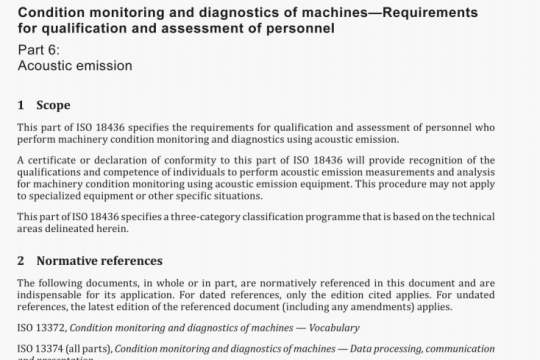BS ISO 16237:2015 pdf free
BS ISO 16237:2015 pdf free.Mechanical joining – Destructive testing of joints
BS ISO 16237 specifies the geometry of the test specimens and the method for the cross-tension testing of single mechanical joints on single-lap test specimens up to a single sheet thickness of 4,5 mm.
The term “sheet”, as used in this International Standard, includes extrusions and cast materials.
The purpose of the cross-tension test is to determine the mechanical characteristics and the failure types of the joints made with different joining methods.
BS ISO 16237 does not apply to civil engineering applications such as metal building and steel construction which are covered by other applicable standards.
The following documents, in whole or in part, are normatively referenced in this document and are indispensable for its application. For dated references, only the edition cited applies. For undated references, the latest edition of the referenced document (including any amendments) applies.
ISO 2768-1, General tolerances一Part 1: Tolerances for linear and angular dimensions without individual tolerance indications
ISO 7500-1, Metallic materials一Verification of static uniaxial testing machines 一Part 1: Tension/compression testing machines一Verification and calibration of the force-measuring system
Testing is performed on a tensile testing machine, which satisfies the requirements given in ISO 7500-1.
The cross-tension force and the displacement shall be simultaneously measured during testing. All tests shall be carried out at room temperature until the joint fails.
If a special clamping device is used, the shape and size shall be specified and recorded.
Crosshead separation rate of testing shall be (less than or) equal to 10 mm/min, and shall be kept constant during the test.
The specimen deformation shall be measured as the displacement of the crosshead or by using appropriate displacement sensing equipment either directly from the specimen or indirectly from the crosshead position. When using signals from the cross head position, the signal should be corrected by the stiffness of the testing machine in question. Results of measurements can only be compared when the tests are performed under identical conditions. The type of measurement and the initial length shall be noted in the test protocol.
The signals for force and specimen deformation during test shall be recorded as shown in Figure 2 so that each specific value shall be recorded in the test report.
NOTE 1 If required, further characteristic data, e.g. 0,3 Fmax, can be determined according to the cross-tension diagram given in Figure 2.BS ISO 16237 pdf download.




